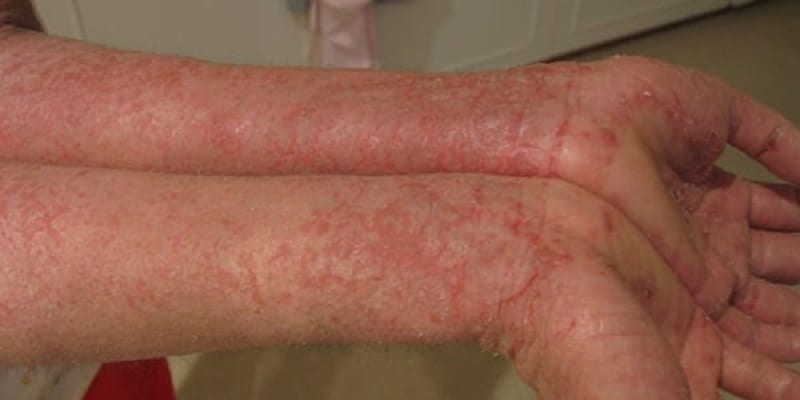IL-23 inhibitors may have a lower risk of paradoxical eczema in comparison to other biologics - 2 Minute Medicine

1. Interleukin-23 inhibitors had a lower risk of developing paradoxical eczema when treated for plaque psoriasis compared to TNF inhibitors, IL-17 inhibitors and IL-12/23
2. Clinical features associated with increased paradoxical eczema risks included increasing age, history of atopic dermatitis, and history of hay fever. The risk was also lower in males.
Evidence Rating Level: 1 (Excellent)
Study Rundown: Biologics targeting tumour necrosis factor (TNF) and various interleukins effectively treat plaque psoriasis but are linked to adverse events such as paradoxical psoriasis, cutaneous lupus, and granulomatous disorders. Reports have also shown the development of paradoxical eczema during biological exposure. However, it needs to be clarified whether the risk of developing eczema varies across clinical features and different classes of biologics. Therefore, this prospective study evaluated three primary outcomes: (1) the incidence of paradoxical eczema as a whole and specific to biologic class, (2) the risk of developing paradoxical eczema between TNF inhibitors and other classes of biologics, and (3) demographic and clinical factors that influence paradoxical eczema. A lower risk of paradoxical eczema was seen among patients treated for plaque psoriasis with IL-23 inhibitors. An increased risk of paradoxical eczema was seen for the clinical features of increasing age and history of atopic dermatitis and hay fever. Lower risk was seen for males. Limitations included the small subgroup sample sizes (e.g., specific biologic exposures and ethnic minority groups). There was also a risk of adverse event misclassification as ascertainment relied on text descriptions from medical records. It was also not possible to directly attribute an adverse event to that of the biologic.
Click to read the study in JAMA Dermatology.
Relevant Reading: Eczematous eruption during anti0interluekin 17 treatment fo psoriasis: an emerging condition
In-Depth [prospective cohort]: This prospective cohort study was completed under the ethics approval of the British Association of Dermatologists Biologics and Immunomodulators Register (BADBIR), which has over 20,000 patients with psoriasis from 168 centres in the UK and Ireland. Patients were included from September 2007 to December 2022 if they met the following criteria: 18 years or older, diagnoses of plaque psoriasis, and exposure to one or more biologics. The biologics included in this study were TNF inhibitors, IL-17 inhibitors, IL-12/23 inhibitors, and IL-23 inhibitors. Systemic therapy start and stop dates, baseline comorbidities/demographics, and adverse event data were collected. To assess for exposures (i.e., paradoxical eczema onset, treatment switch or discontinuation, last documented follow-up, and death), patients were followed every six months for the first three years, then annually afterwards. Of 56,553 drug exposure initially considered, 24,997 (13,699 patients; median age, 46 years [IQR, 36-55 years]; 57% male) were included. Of the 24,997 exposures, 273 (1%) were associated with paradoxical eczema. The incidence (per 100,000 person-years) was 1.22 for IL-17 inhibitors, 0.94 for TNF inhibitors, 0.80 for IL-12/23 inhibitors, and 0.56 for IL-23 inhibitors. IL-23 inhibitors had a lower risk of paradoxical eczema (hazard ratio [HR], 0.39; 95% CI, 0.19-0.81) than TNF inhibitors. Whereas IL-17 (HR, 1.03; 95% CI, 0.74-1.42) and IL-12/23 inhibitors (HR, 0.87; 95% CI, 0.66-1.16) had no associated risk for paradoxical eczema. Clinical features that were associated with a higher risk of paradoxical eczema were increasing age (HR, 1.02 per year; 95% CI, 1.01-1.03), history of atopic dermatitis (HR, 12.40; 95% CI, 6.97-22.06), and history of hay fever (HR, 3.78; 95% CI, 1.49-9.53). A lower risk was seen for males (HR, 0.60; 95% CI, 0.45-0.78) than females. Overall, paradoxical eczema risk in patients treated with biologics for plaque psoriasis was lowest in patients receiving IL-23 inhibitors.
Image: PD
©2023 2 Minute Medicine, Inc. All rights reserved. No works may be reproduced without expressed written consent from 2 Minute Medicine, Inc. Inquire about licensing here. No article should be construed as medical advice and is not intended as such by the authors or by 2 Minute Medicine, Inc.
Comments
Post a Comment